
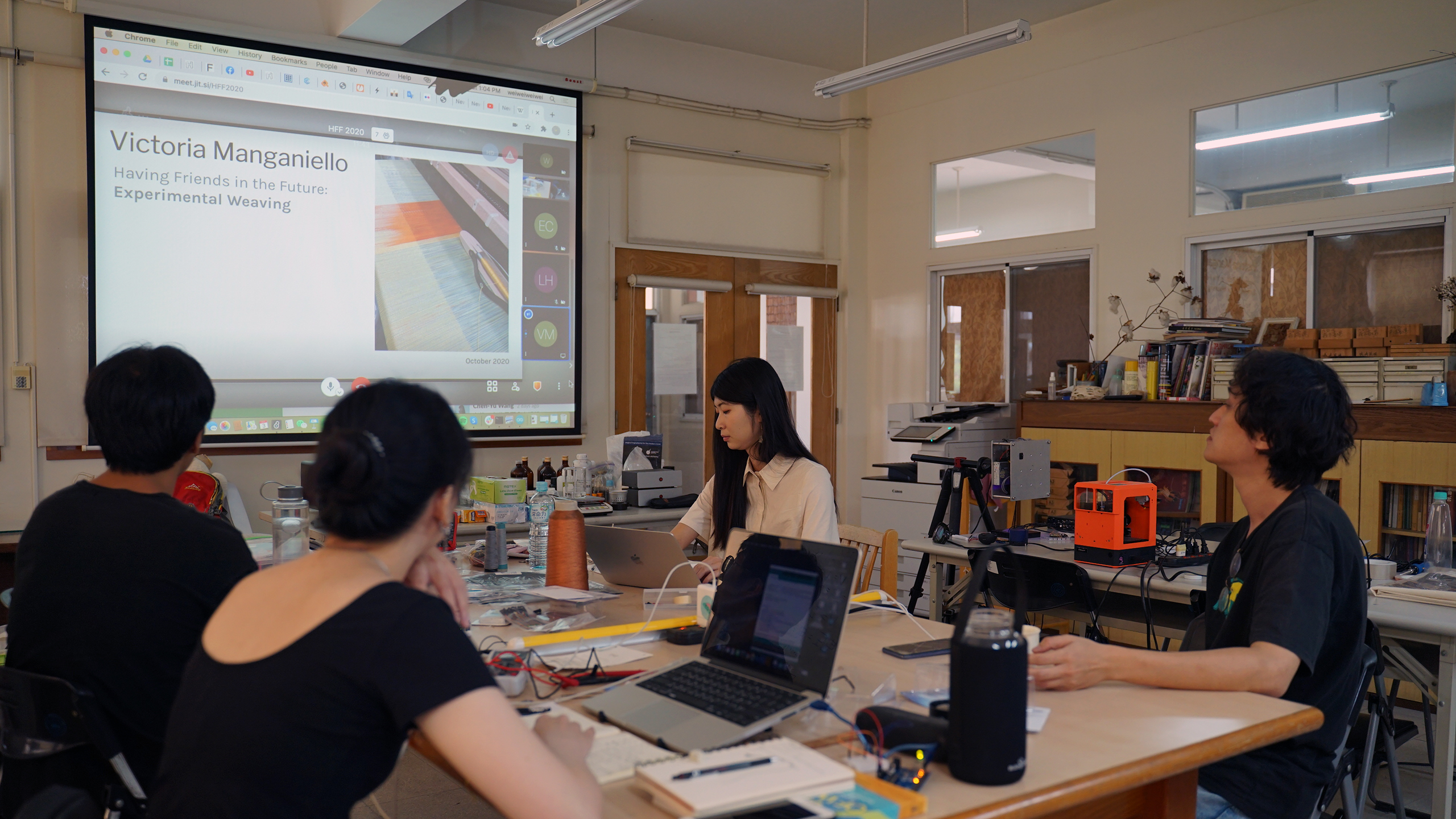


October 3, 2020
lead by Victoria Manganiello
lead by Victoria Manganiello
螢幕:手織歷史
編織是世界各地的人們都在實踐的通用技術,每個人都有自己獨特的方法,材料和靈感。從歷史上看,編織一直被用作一種溝通形式,甚至啟發了我們稱之為螢幕、顯示器和計算機的現代設備。在這個由三部分組成的工作坊中,參與者將通過簡單的圖案應用學習和實踐傑克地織機的基本應用。我們還將在線上與Victoria Manganiello見面,以學習和了解她的織造技術和方法。最後,我們將共同探討紡織品和技術如何重疊的歷史。我們將參加一個合作的講座/工作坊,在其中我們將回顧歷史並推測跨時空的螢幕和顯示器的未來。我們將考慮紡織品在通信中的過去,現在和將來的角色,並發現我們自己的想法,即用軟材料重新構想計算機。最終工作坊將指導參與者提出概念性問題,並與他們共同設計一個新項目,該項目將在面對面研討會系列的其餘部分中執行。鼓勵學生們一起工作,並結合在該計劃中學習到的其他材料和技術。準備探索信息通信的本質和背後的機制,以及軟材料為對話提供的可能性。
在本系列工作坊中,我們回顧了工藝中心工作室使用台式織機進行織造的基礎知識。我們還討論了一些有趣的,非常規的應用,用於通過圖像,視頻和討論進行實驗編織。邀請參與者將他們在整個車間系列中的實驗整合到編織中。此外,我們對屏幕,顯示器和計算機的外觀進行了探索。我們回顧了一些歷史例子,特別注意與紡織品有關的例子。我們通過自己的研究以及發明自己的探索性投機歷史來擴展這一歷史。我們討論了「什麼使我們成為人類」的問題,未來的螢幕應該是什麼樣子?我們希望未來的技術世界會是什麼樣子?我們希望能夠合作創建有趣的原型,以探索這些問題以及其他相關問題的答案。
對參與者的邀請
工作坊結束後,參與者被期待(與他們的本地朋友,他們的遠端朋友或單獨的)將對工作坊中探索的提示進行概念化。 他們可以使用編織或任何其他紡織品類型的材料來創建推測式的「未來螢幕」。 它可以是半功能的,全功能的,甚至是非功能性的但具有推測性。 強烈建議對其過程、技術、工具和實驗進行記錄。 請參考此方法來為樣片交換計劃來創建一個樣片。
Screens: A Hands-on History with Weaving
Weaving is a universal technique practiced by people all around the globe, each with their unique approach, material, and inspiration. Historically, weaving has been used as a form of communication and even inspired the modern-day devices that we call screens, displays and computers. In this three-part workshop, participants will learn and practice the basic application of the Jack Floor Loom with simple pattern application. We will also meet Victoria Manganiello online to learn and see more of her specific technique and approach to weaving. Lastly, we will work together to explore the history of how textiles and technology have overlapped. We will engage in a collaborative lecture/workshop where we will look at the history and speculate on the future of screens and displays across time and space. We will contemplate the past, present, and future roles of textiles in communication and discover our own ideas for reimagining the computer with soft materials. The final workshop will guide participants in conceptual questions with the mission to co-design a new project to be executed during the remainder of the in-person workshop series. It will be encouraged that students work together and also incorporate other materials and techniques learned during this program. Come ready to explore the nature of and mechanisms behind information communication and the possibilities that soft materiality can offer to that conversation.
Progress from workshop
In this workshop series, we reviewed the basics of weaving using the table loom at NCTRI studios. And we discussed some exciting and unconventional applications for experimental weaving through images, video, and discussion. Participants have been invited to integrate their experiments across the entire workshop series into the setting of weaving. Additionally, we did an exploration of what a screen, display, and computer can be. We reviewed some historical examples with special attention to those that connect with textiles. And we expanded on that history with our own research as well as by inventing our own explored speculative histories. We asked the questions "what makes us human" what should the screens of the future look like? What do we want the world of technology to be like in the future? And we hope to collaborate together to create interesting prototypes that explore answers to these and other related questions. Join us in the "Soft Monitor" channel in Slack to continue the dialogue and to share updates of your own exploration of these topics.
Expectations of Participants
After this workshop, participants are expected to conceptualize (in groups with their local friends, their remote friends, or individually) their own interpretation of the prompts explored in the workshops. They can use weaving or any other textile type material to create a speculative "screen of the future." It can be semi-functional, fully-functional, or even non-functional but speculative. Documentation of their process, technique, tools and experimentation is highly encouraged. Please use this method to make a swatch for the swatch exchange.
visit wiki
編織是世界各地的人們都在實踐的通用技術,每個人都有自己獨特的方法,材料和靈感。從歷史上看,編織一直被用作一種溝通形式,甚至啟發了我們稱之為螢幕、顯示器和計算機的現代設備。在這個由三部分組成的工作坊中,參與者將通過簡單的圖案應用學習和實踐傑克地織機的基本應用。我們還將在線上與Victoria Manganiello見面,以學習和了解她的織造技術和方法。最後,我們將共同探討紡織品和技術如何重疊的歷史。我們將參加一個合作的講座/工作坊,在其中我們將回顧歷史並推測跨時空的螢幕和顯示器的未來。我們將考慮紡織品在通信中的過去,現在和將來的角色,並發現我們自己的想法,即用軟材料重新構想計算機。最終工作坊將指導參與者提出概念性問題,並與他們共同設計一個新項目,該項目將在面對面研討會系列的其餘部分中執行。鼓勵學生們一起工作,並結合在該計劃中學習到的其他材料和技術。準備探索信息通信的本質和背後的機制,以及軟材料為對話提供的可能性。
在本系列工作坊中,我們回顧了工藝中心工作室使用台式織機進行織造的基礎知識。我們還討論了一些有趣的,非常規的應用,用於通過圖像,視頻和討論進行實驗編織。邀請參與者將他們在整個車間系列中的實驗整合到編織中。此外,我們對屏幕,顯示器和計算機的外觀進行了探索。我們回顧了一些歷史例子,特別注意與紡織品有關的例子。我們通過自己的研究以及發明自己的探索性投機歷史來擴展這一歷史。我們討論了「什麼使我們成為人類」的問題,未來的螢幕應該是什麼樣子?我們希望未來的技術世界會是什麼樣子?我們希望能夠合作創建有趣的原型,以探索這些問題以及其他相關問題的答案。
對參與者的邀請
工作坊結束後,參與者被期待(與他們的本地朋友,他們的遠端朋友或單獨的)將對工作坊中探索的提示進行概念化。 他們可以使用編織或任何其他紡織品類型的材料來創建推測式的「未來螢幕」。 它可以是半功能的,全功能的,甚至是非功能性的但具有推測性。 強烈建議對其過程、技術、工具和實驗進行記錄。 請參考此方法來為樣片交換計劃來創建一個樣片。
Screens: A Hands-on History with Weaving
Weaving is a universal technique practiced by people all around the globe, each with their unique approach, material, and inspiration. Historically, weaving has been used as a form of communication and even inspired the modern-day devices that we call screens, displays and computers. In this three-part workshop, participants will learn and practice the basic application of the Jack Floor Loom with simple pattern application. We will also meet Victoria Manganiello online to learn and see more of her specific technique and approach to weaving. Lastly, we will work together to explore the history of how textiles and technology have overlapped. We will engage in a collaborative lecture/workshop where we will look at the history and speculate on the future of screens and displays across time and space. We will contemplate the past, present, and future roles of textiles in communication and discover our own ideas for reimagining the computer with soft materials. The final workshop will guide participants in conceptual questions with the mission to co-design a new project to be executed during the remainder of the in-person workshop series. It will be encouraged that students work together and also incorporate other materials and techniques learned during this program. Come ready to explore the nature of and mechanisms behind information communication and the possibilities that soft materiality can offer to that conversation.
Progress from workshop
In this workshop series, we reviewed the basics of weaving using the table loom at NCTRI studios. And we discussed some exciting and unconventional applications for experimental weaving through images, video, and discussion. Participants have been invited to integrate their experiments across the entire workshop series into the setting of weaving. Additionally, we did an exploration of what a screen, display, and computer can be. We reviewed some historical examples with special attention to those that connect with textiles. And we expanded on that history with our own research as well as by inventing our own explored speculative histories. We asked the questions "what makes us human" what should the screens of the future look like? What do we want the world of technology to be like in the future? And we hope to collaborate together to create interesting prototypes that explore answers to these and other related questions. Join us in the "Soft Monitor" channel in Slack to continue the dialogue and to share updates of your own exploration of these topics.
Expectations of Participants
After this workshop, participants are expected to conceptualize (in groups with their local friends, their remote friends, or individually) their own interpretation of the prompts explored in the workshops. They can use weaving or any other textile type material to create a speculative "screen of the future." It can be semi-functional, fully-functional, or even non-functional but speculative. Documentation of their process, technique, tools and experimentation is highly encouraged. Please use this method to make a swatch for the swatch exchange.
visit wiki




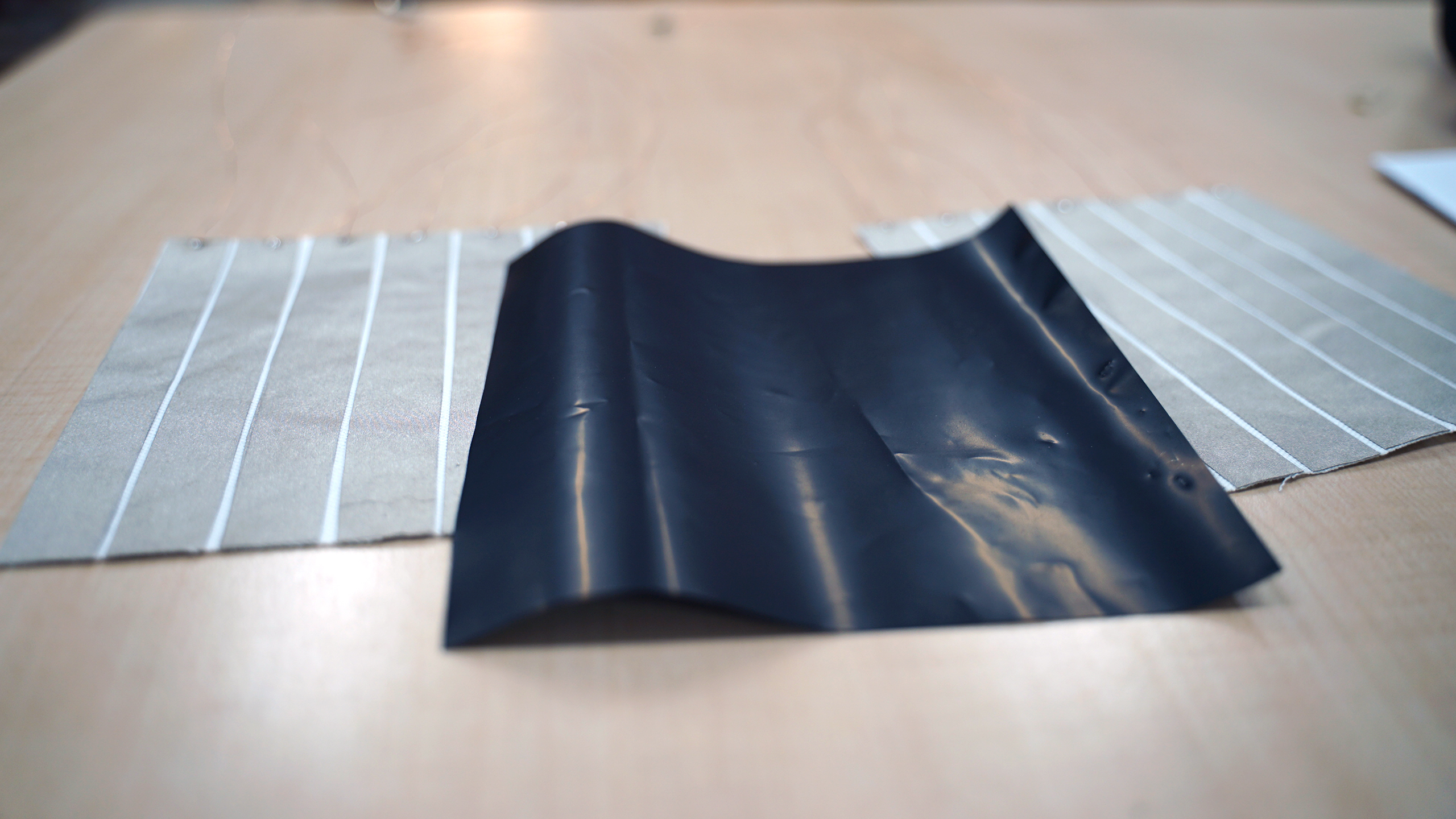
October 3, 2020
lead by 施惟捷 Shih Wei Chieh
lead by 施惟捷 Shih Wei Chieh
電子織品入門、導電刺繡
e-Textile basics, embroidered circuits
This class expects students to learn the basic properties of conductive sutures, basic electronic welding capabilities, the use of Arduino controllers and sensors, and the concept of using sensors to describe the real world as digital data.
visit wiki
- 分壓電路
-
壓力感應
- 壓力感應矩陣
-
連結arduino到max/msp
- 分壓電路刺繡
e-Textile basics, embroidered circuits
This class expects students to learn the basic properties of conductive sutures, basic electronic welding capabilities, the use of Arduino controllers and sensors, and the concept of using sensors to describe the real world as digital data.
- voltage divider ciruits
-
pressing sensor
-
pressing sensor matrix
- connect arduino to max/msp
- voltage divider embroidery
visit wiki

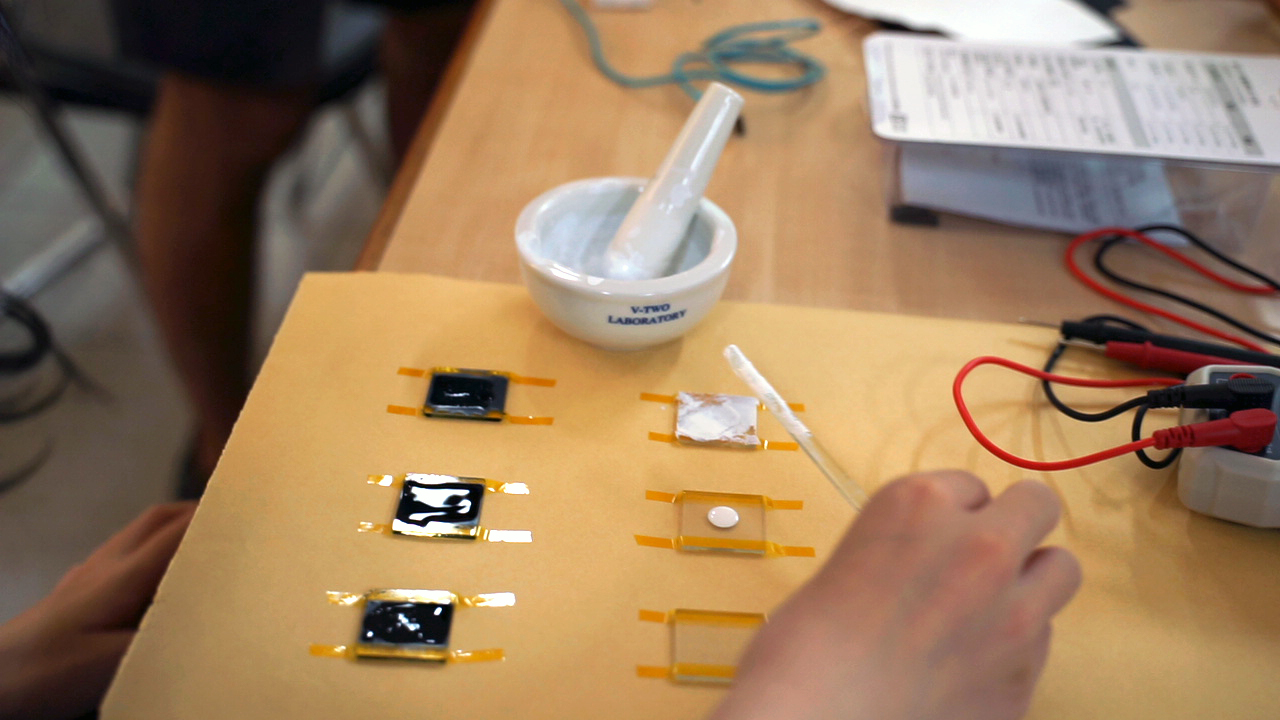





October 4, 2020
lead by Maya Minder, Sandra Bühler, Shih Wei Chieh
lead by Maya Minder, Sandra Bühler, Shih Wei Chieh
藍染染敏太陽能電池
關於天然藍染染料的表演式演:這個線上工作坊的第一部分是對藍染商品歷史的一次演講表演,這種看法是通過生態女權主義的觀點引發的,我們想挖掘出後殖民主義,以探究歐洲垂死技術歷史的隱藏痕跡。在發明合成色之前,在紡織品上使用深色光澤是財富,知識和力量的財富。自然傳播的靛藍植物(Indigofera tinctoria)使印度,非洲和中國在歐洲半球有了植物的對應物。也被稱為德國靛藍,它被稱為染色棉或松藍(Isatis tinctoria),並且具有悠久的歷史。兩種植物都帶有「印度糖」的化合物,該化合物通過酶作用將氧化還原氧化成靛藍染料。天然地生產著色劑是複雜的,而隱藏的歷史則主要依賴於商人關於財富,貿易和前現代全球糾纏的故事。直到今天,藍色仍然是基督教徒對瑪莉母親長袍顏色的描述,象徵著沉穩,清晰和距離。在中世紀,以某種方式生產這種著色劑是一個複雜的過程,並成為世界許多文化中一種受到嚴格保護的公會技術:日本的絞染,Blaudruck,來自法國的丹寧牛仔布,來自斯洛伐克的Modrotlač,或匈牙利的Kékfestés。
德語用語「blau machen」,意思是跳過工作或上學並度過閒暇時光。我們發現它某種程度上借鑒了中世紀染藍紡織品的工藝,即「Blaufärben」的工藝。藍色是有毒的,需要化學過程才能首先啟動還原染料浴。我們發現,在中世紀,這與在社區中喝啤酒的慶祝活動有關,因為它需要大量的小便來創建桶染浴。我們以此為出發點,將歷史敘述化為猜測式設計故事,一個探索拋開了時間的節點,而在黑暗中的中世紀,貿易和文化交流的全球,精神,生態相互聯繫也引發了生態女性主義者的觀點。
我們工作坊的第二部分是以DIY方式誘導染料合成太陽能電池,以推測技術在使用隱含染料合成太陽能電池的未來電子紡織品中的作用,並嘗試由藍染來為染敏太陽能電池染色。染料敏化太陽能電池(DSSC,DSC,DYSC或Grätzel cell)是屬於薄膜太陽能類型的低成本太陽能電池。它基於在光敏陽極和電解質之間形成的半導體,光電化學系統。染料太陽能電池的現代版本,也稱為Grätzel電池,最初由柏克萊加州大學的Brian O'Regan和MichaelGrätzel於1988年共同發明,後來由上述科學家在ÉcolePolytechniqueFédéralede瑞士洛桑(EPFL),直到1991年第一個高效DSSC出版為止。MichaelGrätzel因這項發明而獲得了2010年千禧技術獎。所有太陽能電池技術的靈感都來自自然界通過光合作用將太陽轉化為能量的能力。
Indigo Grätzel Cell (DSSC)
Lecture Performance on Natural Dye Indig: Part of this online workshop was an lecture performance into the commodity history of indigo blue approached to ecofeminist views threw the postcolonial we want to dig into hidden traces of history of european dying technics. Before the invention of synthetic colors the run on deep shiny colors in textile was a fortune of wealth, knowledge and power. The Plant indigo (Indigofera tinctoria) which is naturally spread threw India, Africa and China had a counterpart of plant in the European hemispheres. Also known as the German Indigo it is named dyers woad or glastum (Isatis tinctoria) and has a rich history. Both plants carry the chemical compound of glycose indican that turns enzymatically threw a redox-oxidation into indigo dye. As complex it is to produce the colorant naturally, as hidden its history that relied mostly on merchants stories of wealth, trade and pre-modern global entanglements. The color blue until today is relied in christian depictions to the color of Mother Mary's gown and symbolizes calm, clarity and distance. Somehow in medieval times it was a complex process to produce this colorant and became a well guarded guilds technic in many cultures around the world: Shibori in Japan, Blaudruck in Germany, Denim from France, Modrotlač in Slovakia, or Kékfestés in Hungaria.
The german term blau machen, meaning to skip work or school and take leisure time. We found out it somehow takes a reference to the medieval technic of dying textiles blue, the process of Blaufärben. Blue coloring was toxic and needed a chemical process to firstly initiate the vat dye bath. We found out that in medieval times this was connected to a celebration of drinkin beer in a community, since it needed lots of pee to create the vat dye bath. We took this as a starting point to render historical narration into a speculative story telling, a quest threw nodes of time and global, spiritual, ecological interrelation of trade and cultural exchange in the dark hidden medieval times threw a Ecofeminists point of view.
The second part of our workshop was inducting the dye synthesized solar cell in DIY approach to speculate into role of technics in future e-textiles using implimented dye synthesized solar cells. A dye-sensitized solar cell (DSSC, DSC, DYSC or Grätzel cell) is a low-cost solar cell belonging to the group of thin film solar cells. It is based on a semiconductor formed between a photo-sensitized anode and an electrolyte, a photoelectro-chemical system. The modern version of a dye solar cell, also known as the Grätzel cell, was originally co-invented in 1988 by Brian O'Regan and Michael Grätzel at UC Berkeley and this work was later developed by the aforementioned scientists at the École Polytechnique Fédérale de Lausanne, Swiss (EPFL) until the publication of the first high efficiency DSSC in 1991. Michael Grätzel has been awarded the 2010 Millennium Technology Prize for this invention. All Solar Cell Technic is inspired by nature's ability of transforming sun into energy by photosynthesis.
visit wiki
關於天然藍染染料的表演式演:這個線上工作坊的第一部分是對藍染商品歷史的一次演講表演,這種看法是通過生態女權主義的觀點引發的,我們想挖掘出後殖民主義,以探究歐洲垂死技術歷史的隱藏痕跡。在發明合成色之前,在紡織品上使用深色光澤是財富,知識和力量的財富。自然傳播的靛藍植物(Indigofera tinctoria)使印度,非洲和中國在歐洲半球有了植物的對應物。也被稱為德國靛藍,它被稱為染色棉或松藍(Isatis tinctoria),並且具有悠久的歷史。兩種植物都帶有「印度糖」的化合物,該化合物通過酶作用將氧化還原氧化成靛藍染料。天然地生產著色劑是複雜的,而隱藏的歷史則主要依賴於商人關於財富,貿易和前現代全球糾纏的故事。直到今天,藍色仍然是基督教徒對瑪莉母親長袍顏色的描述,象徵著沉穩,清晰和距離。在中世紀,以某種方式生產這種著色劑是一個複雜的過程,並成為世界許多文化中一種受到嚴格保護的公會技術:日本的絞染,Blaudruck,來自法國的丹寧牛仔布,來自斯洛伐克的Modrotlač,或匈牙利的Kékfestés。
德語用語「blau machen」,意思是跳過工作或上學並度過閒暇時光。我們發現它某種程度上借鑒了中世紀染藍紡織品的工藝,即「Blaufärben」的工藝。藍色是有毒的,需要化學過程才能首先啟動還原染料浴。我們發現,在中世紀,這與在社區中喝啤酒的慶祝活動有關,因為它需要大量的小便來創建桶染浴。我們以此為出發點,將歷史敘述化為猜測式設計故事,一個探索拋開了時間的節點,而在黑暗中的中世紀,貿易和文化交流的全球,精神,生態相互聯繫也引發了生態女性主義者的觀點。
我們工作坊的第二部分是以DIY方式誘導染料合成太陽能電池,以推測技術在使用隱含染料合成太陽能電池的未來電子紡織品中的作用,並嘗試由藍染來為染敏太陽能電池染色。染料敏化太陽能電池(DSSC,DSC,DYSC或Grätzel cell)是屬於薄膜太陽能類型的低成本太陽能電池。它基於在光敏陽極和電解質之間形成的半導體,光電化學系統。染料太陽能電池的現代版本,也稱為Grätzel電池,最初由柏克萊加州大學的Brian O'Regan和MichaelGrätzel於1988年共同發明,後來由上述科學家在ÉcolePolytechniqueFédéralede瑞士洛桑(EPFL),直到1991年第一個高效DSSC出版為止。MichaelGrätzel因這項發明而獲得了2010年千禧技術獎。所有太陽能電池技術的靈感都來自自然界通過光合作用將太陽轉化為能量的能力。
Indigo Grätzel Cell (DSSC)
Lecture Performance on Natural Dye Indig: Part of this online workshop was an lecture performance into the commodity history of indigo blue approached to ecofeminist views threw the postcolonial we want to dig into hidden traces of history of european dying technics. Before the invention of synthetic colors the run on deep shiny colors in textile was a fortune of wealth, knowledge and power. The Plant indigo (Indigofera tinctoria) which is naturally spread threw India, Africa and China had a counterpart of plant in the European hemispheres. Also known as the German Indigo it is named dyers woad or glastum (Isatis tinctoria) and has a rich history. Both plants carry the chemical compound of glycose indican that turns enzymatically threw a redox-oxidation into indigo dye. As complex it is to produce the colorant naturally, as hidden its history that relied mostly on merchants stories of wealth, trade and pre-modern global entanglements. The color blue until today is relied in christian depictions to the color of Mother Mary's gown and symbolizes calm, clarity and distance. Somehow in medieval times it was a complex process to produce this colorant and became a well guarded guilds technic in many cultures around the world: Shibori in Japan, Blaudruck in Germany, Denim from France, Modrotlač in Slovakia, or Kékfestés in Hungaria.
The german term blau machen, meaning to skip work or school and take leisure time. We found out it somehow takes a reference to the medieval technic of dying textiles blue, the process of Blaufärben. Blue coloring was toxic and needed a chemical process to firstly initiate the vat dye bath. We found out that in medieval times this was connected to a celebration of drinkin beer in a community, since it needed lots of pee to create the vat dye bath. We took this as a starting point to render historical narration into a speculative story telling, a quest threw nodes of time and global, spiritual, ecological interrelation of trade and cultural exchange in the dark hidden medieval times threw a Ecofeminists point of view.
The second part of our workshop was inducting the dye synthesized solar cell in DIY approach to speculate into role of technics in future e-textiles using implimented dye synthesized solar cells. A dye-sensitized solar cell (DSSC, DSC, DYSC or Grätzel cell) is a low-cost solar cell belonging to the group of thin film solar cells. It is based on a semiconductor formed between a photo-sensitized anode and an electrolyte, a photoelectro-chemical system. The modern version of a dye solar cell, also known as the Grätzel cell, was originally co-invented in 1988 by Brian O'Regan and Michael Grätzel at UC Berkeley and this work was later developed by the aforementioned scientists at the École Polytechnique Fédérale de Lausanne, Swiss (EPFL) until the publication of the first high efficiency DSSC in 1991. Michael Grätzel has been awarded the 2010 Millennium Technology Prize for this invention. All Solar Cell Technic is inspired by nature's ability of transforming sun into energy by photosynthesis.
visit wiki
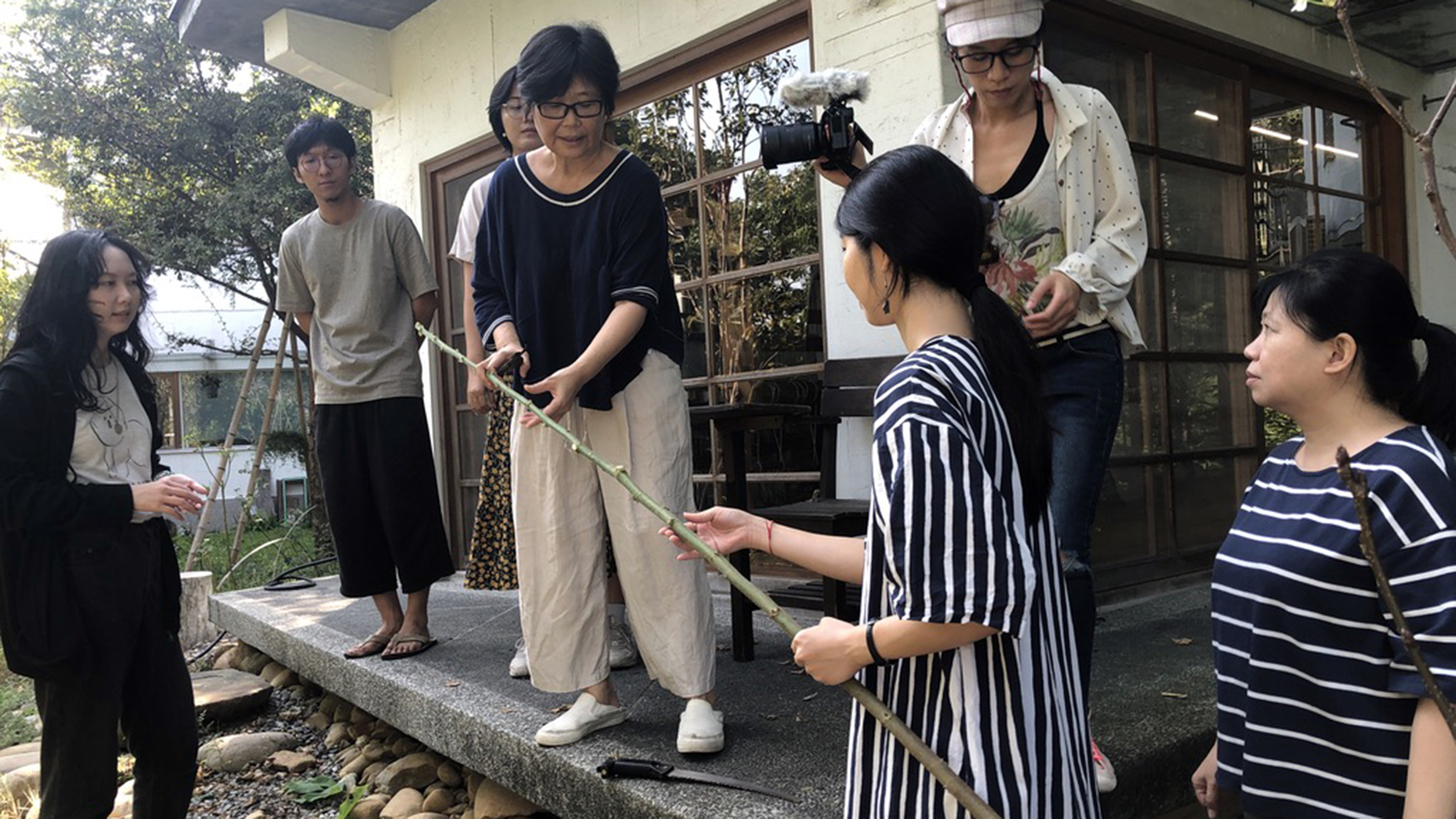


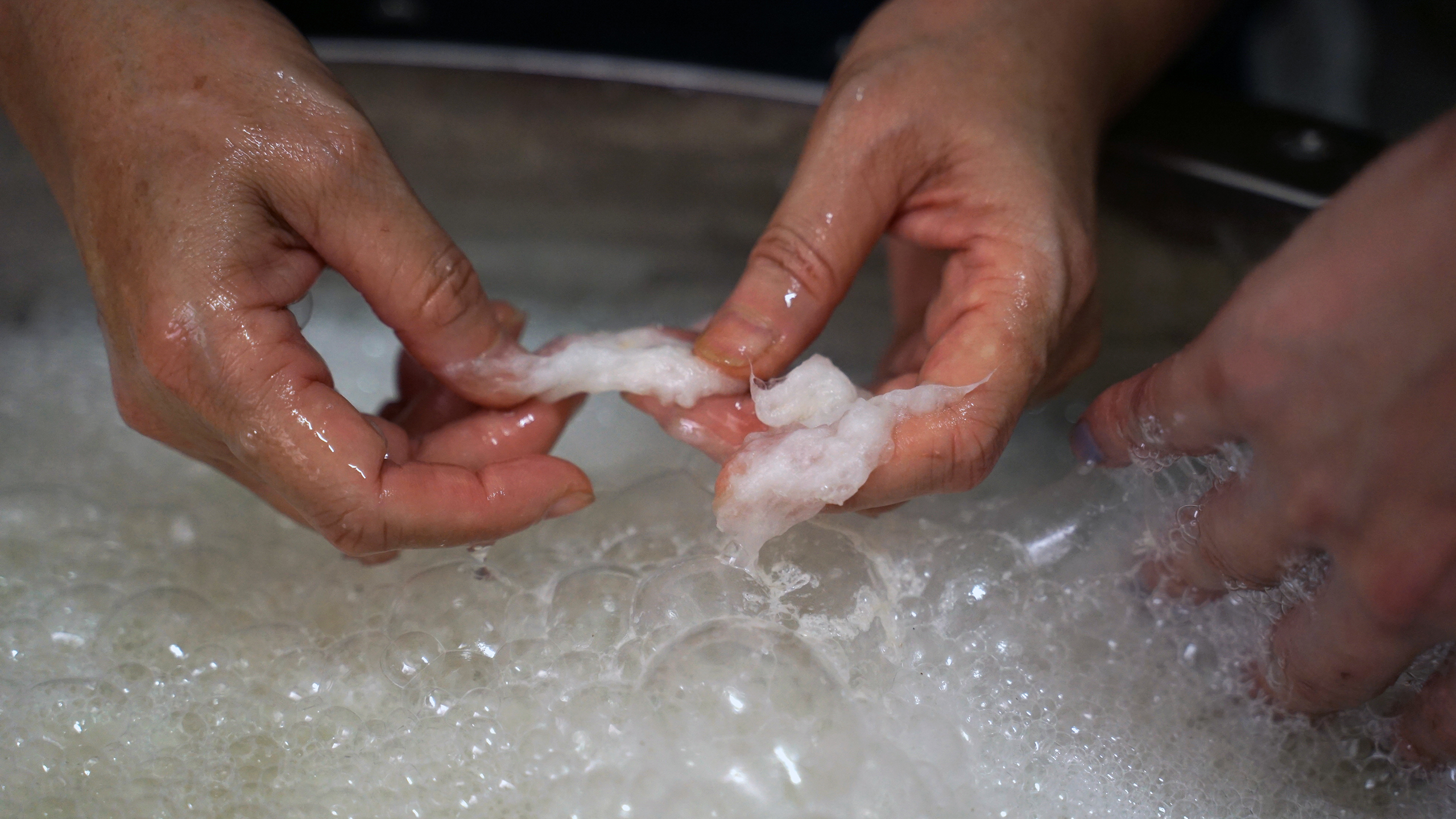

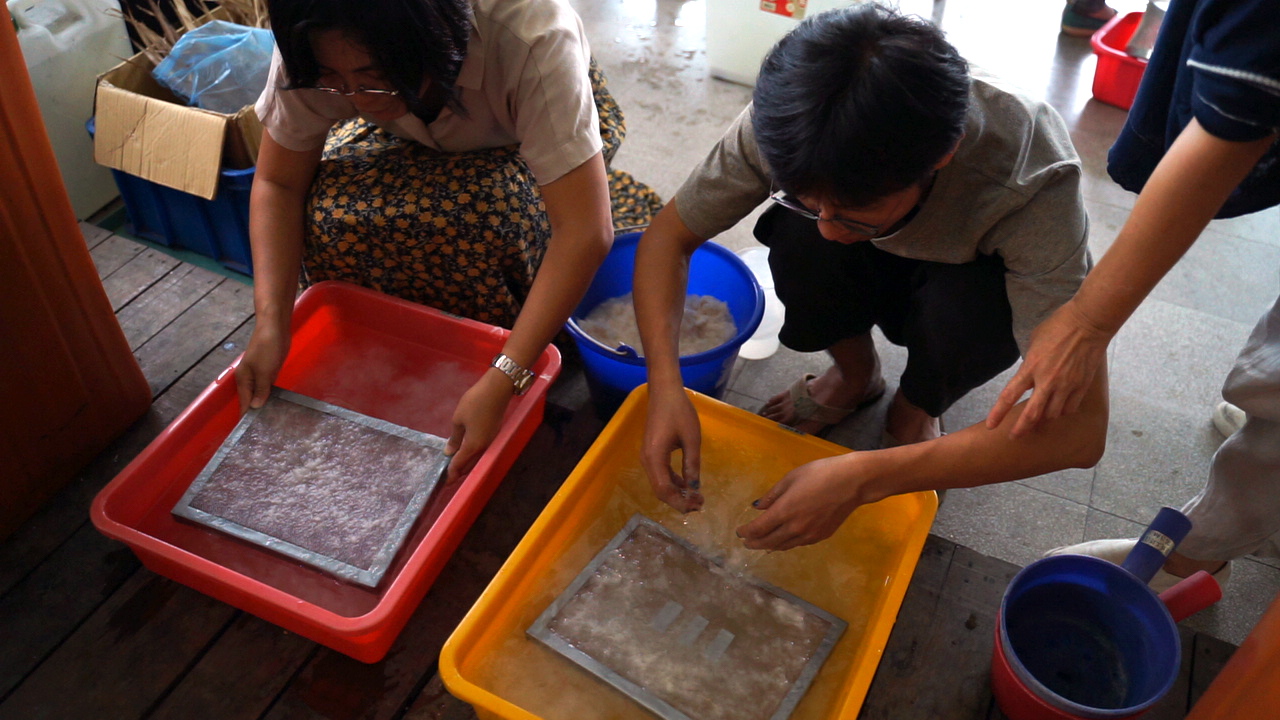
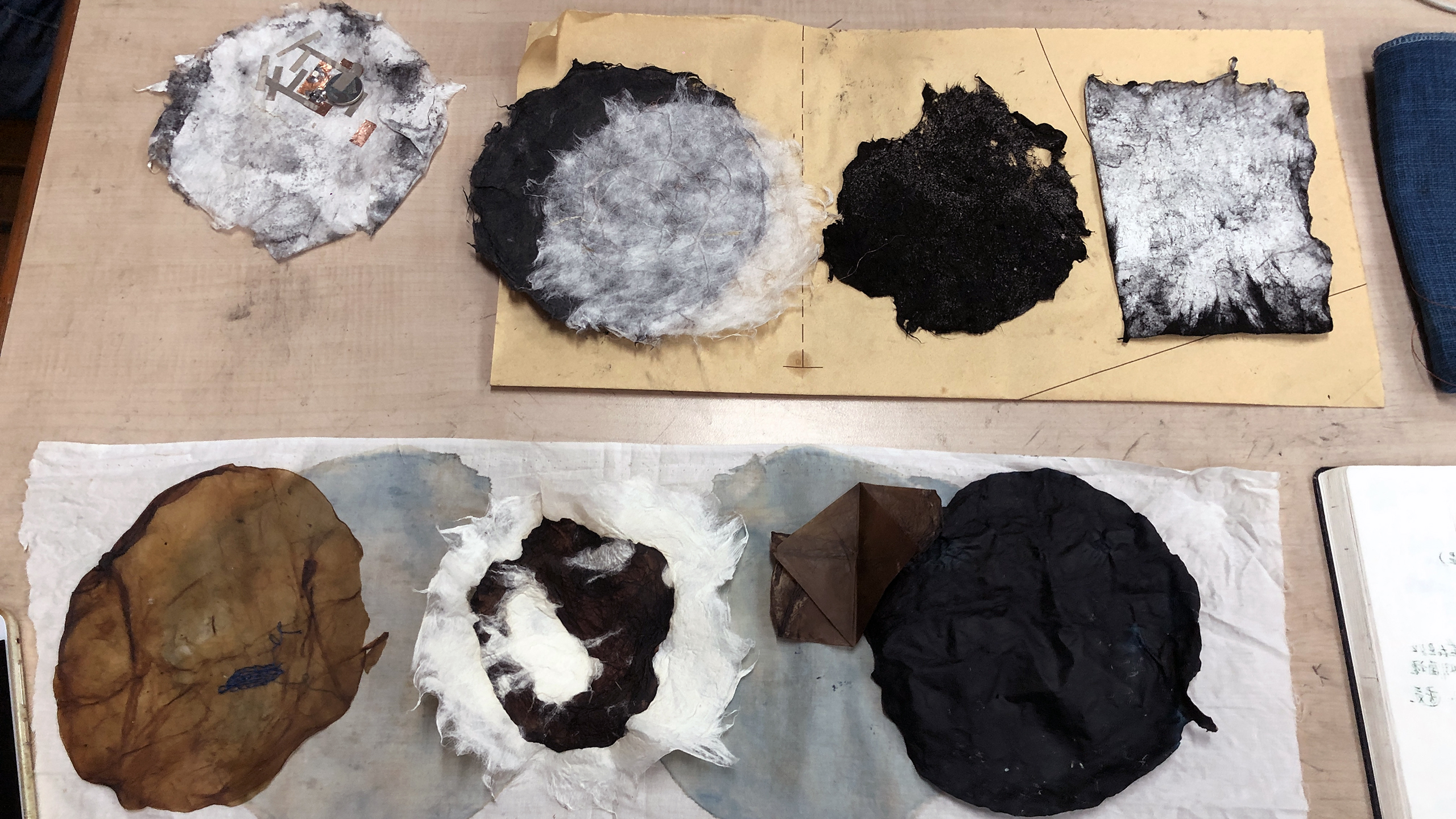
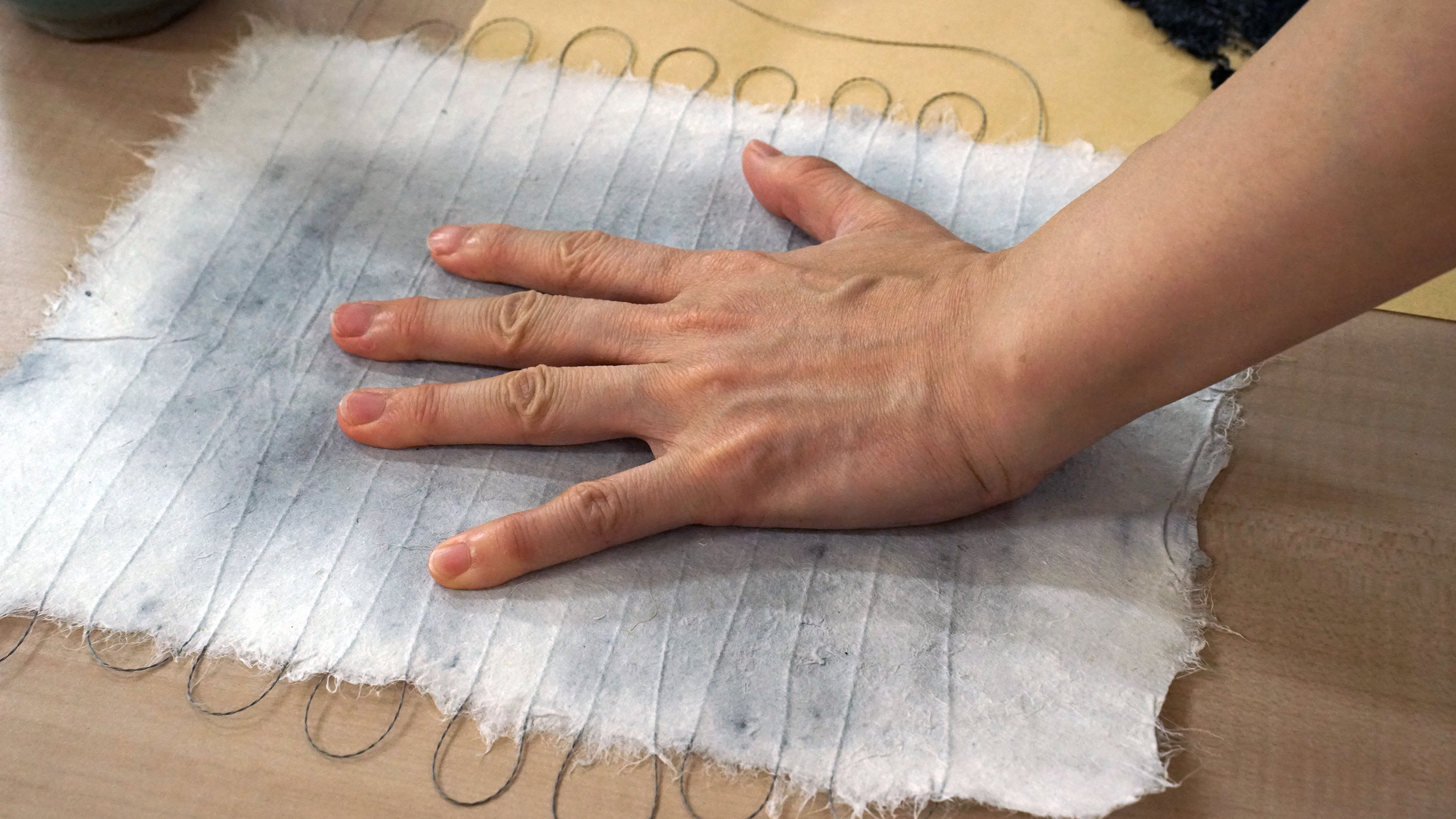
October 5, 2020
楊偉林主持
lead by Wei Ling Yang
楊偉林主持
lead by Wei Ling Yang
手抄紙和感應紙
這是一堂體驗傳統手抄紙做法的工作坊,偉林先邀請我們到她自家的院子體驗親手採集構樹,並透過不斷的敲打將其纖維分散。下午的實驗她亦示範了如何用工藝中心的打漿機備漿,利用抄網將紙漿做成手工紙。工作坊最後亦使用構樹紙漿和不繡鋼縫線、溫致變色油墨、活性碳、碳黑等材料混合,製造簡單的感應器和互動纖維介面。Hand Sheet Paper Making and Paper Sensors
This is a workshop to experience traditional hand-made paper methods. Wei Lin Yang first invited us to her own yard to experience collecting paper mulberry and dispersing its fibers through constant beating with hamer. In the afternoon experiment, she also demonstrated how to use the pulp beater in NTCRI to refining the pulp and use the dipping screen to fix the fibre into piece of paper. At the end of the workshop, paper mulberry pulp and stainless steel sutures, thermochromic ink, activated carbon, carbon black and other materials were mixed in order to create simple sensors and interactive fiber interfaces.
visit wiki
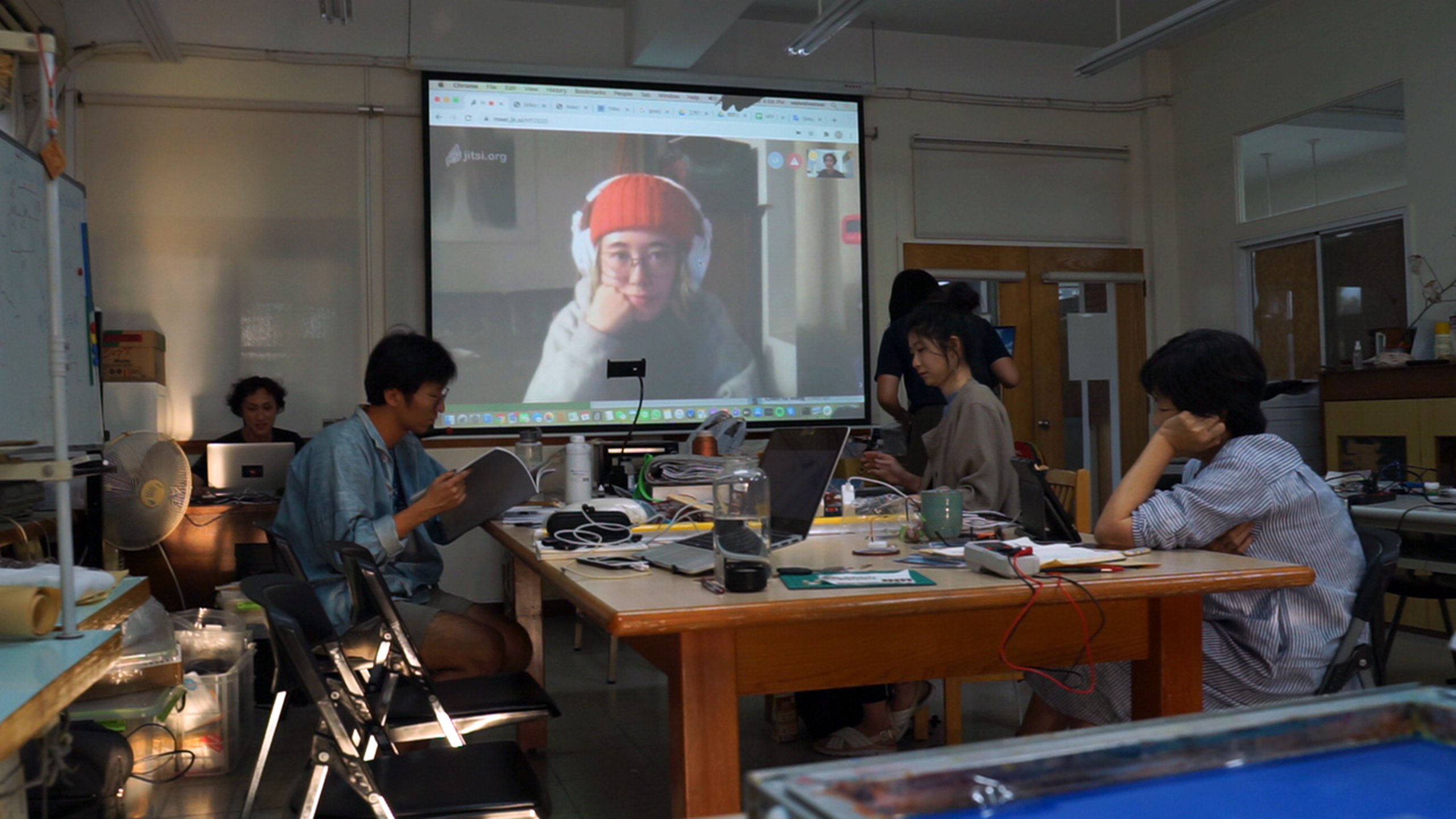




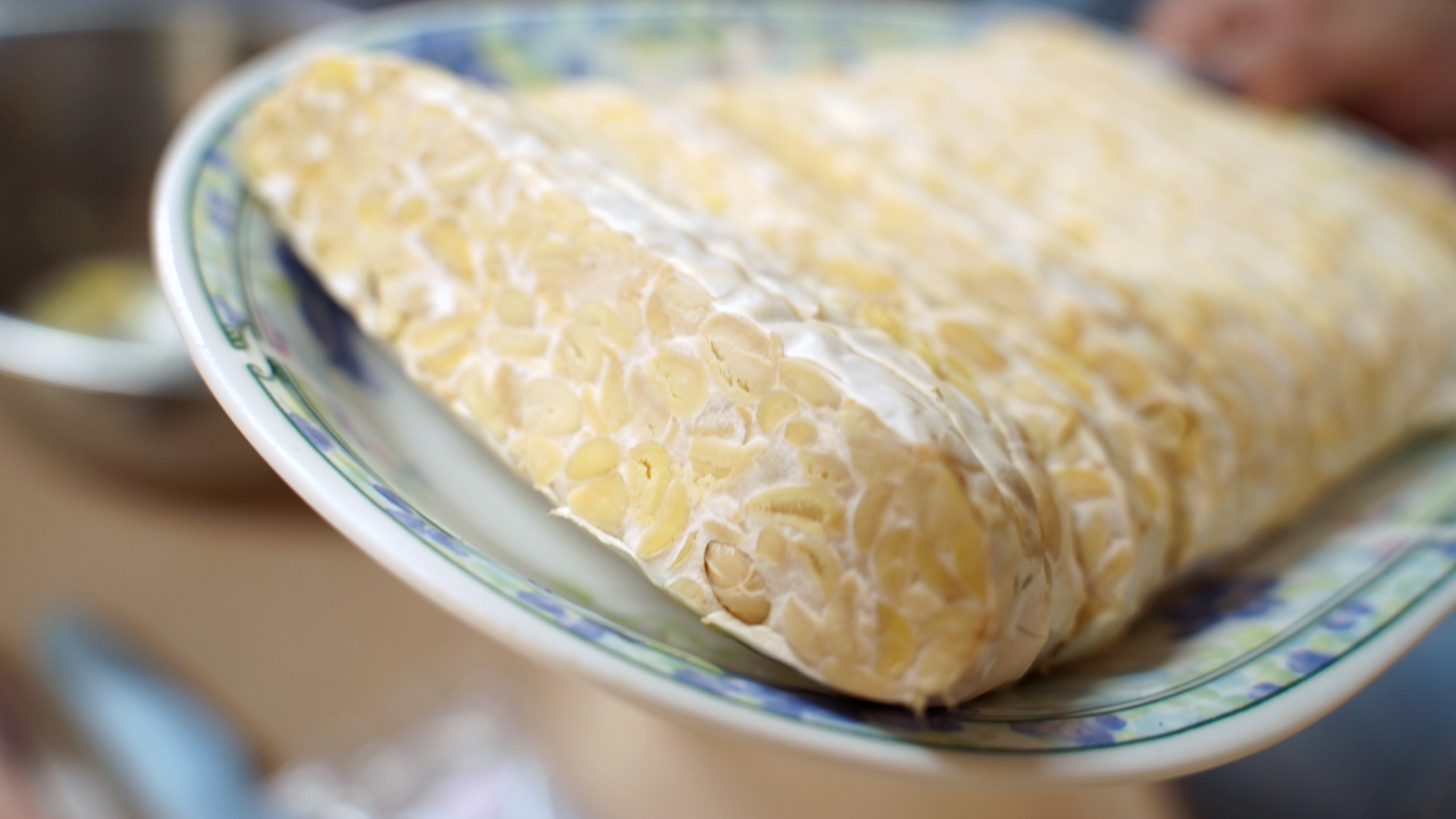


October 6, 2020
陳科廷主持
lead by Keting Chen
陳科廷主持
lead by Keting Chen
印尼天貝和紅茶菌培養工作坊
這場工作坊裡介紹了兩種發酵的食物,第一種是來自印尼的天貝,雖然使用天貝做為替代材料的例子還很少,但是其容易製作的特性和驚人的體積增長速度依然 十分吸引人!第二種是紅茶菌(康普茶),在工作坊中藝術家陳科廷從相鄰連線草屯工作坊,介紹了他習慣的紅茶菌寄存方式。在這之後,另兩 位活動參與者Giulia Tomasello和Ananda也從遠方替換了分享他們的飼養心得,以及他們對紅茶菌纖維的各種實驗嘗試。
Tempe and kombucha cultivation workshop
Two kinds of fermented food were introduced in this workshop. The first one is tempeh from Indonesia. Although there are still very few examples of using tempeh as an alternative material, its easy-to-make characteristics and amazing volume growth rate are still very fanscinating! The second fermented food is kombucha (kombucha). In the workshop, artist Chen Keting introduced his very tips of cultivating kombucha. After that, the other two event participants, Giulia Tomasello and Ananda Gabo, also shared their cultivating experience and various experiments on kombucha fiber from remote.
visit wiki
這場工作坊裡介紹了兩種發酵的食物,第一種是來自印尼的天貝,雖然使用天貝做為替代材料的例子還很少,但是其容易製作的特性和驚人的體積增長速度依然 十分吸引人!第二種是紅茶菌(康普茶),在工作坊中藝術家陳科廷從相鄰連線草屯工作坊,介紹了他習慣的紅茶菌寄存方式。在這之後,另兩 位活動參與者Giulia Tomasello和Ananda也從遠方替換了分享他們的飼養心得,以及他們對紅茶菌纖維的各種實驗嘗試。
Tempe and kombucha cultivation workshop
Two kinds of fermented food were introduced in this workshop. The first one is tempeh from Indonesia. Although there are still very few examples of using tempeh as an alternative material, its easy-to-make characteristics and amazing volume growth rate are still very fanscinating! The second fermented food is kombucha (kombucha). In the workshop, artist Chen Keting introduced his very tips of cultivating kombucha. After that, the other two event participants, Giulia Tomasello and Ananda Gabo, also shared their cultivating experience and various experiments on kombucha fiber from remote.
visit wiki
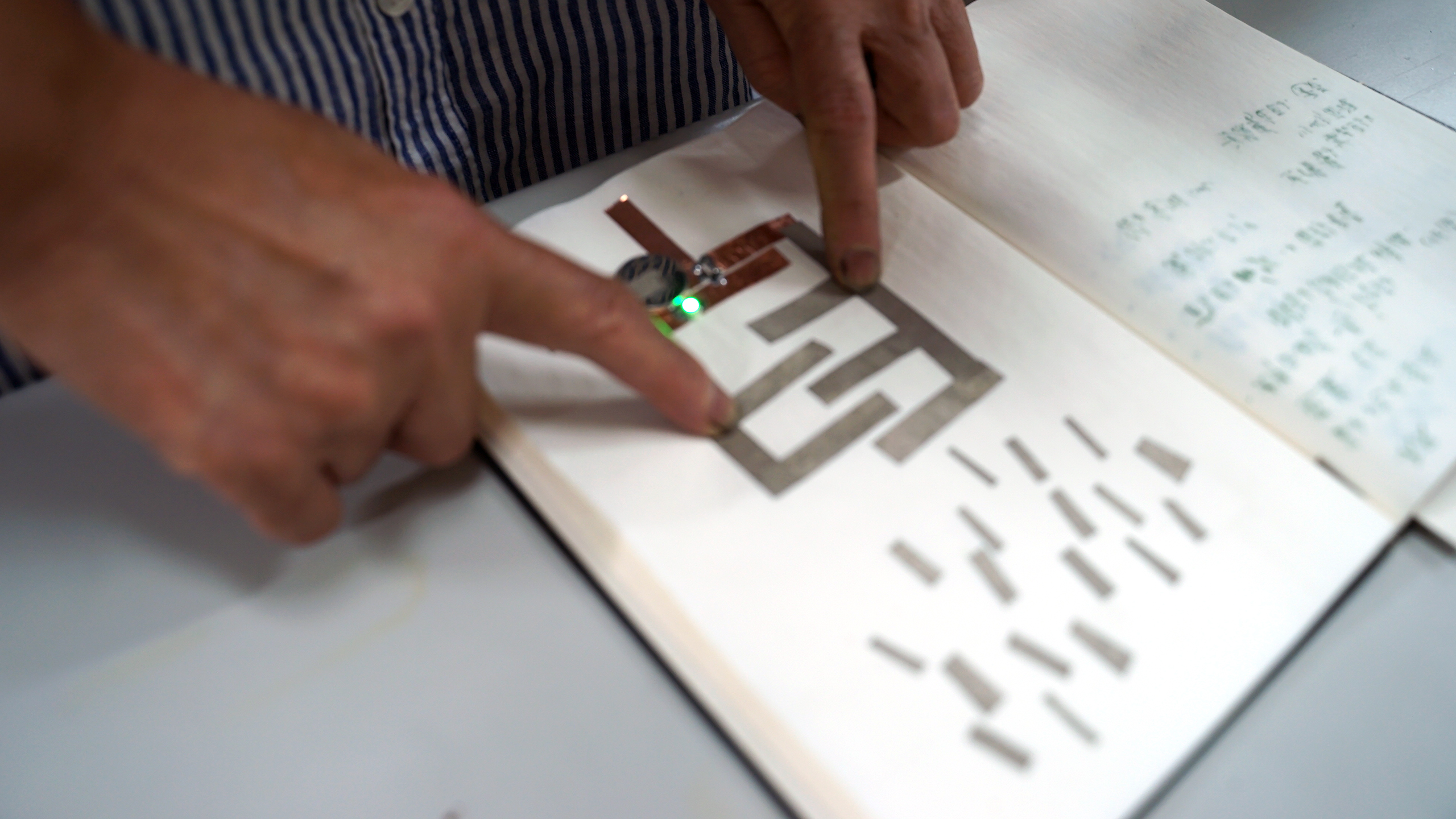






October 6, 2020
lead by Zohar Messeca Ferra, Audrey Briot
lead by Zohar Messeca Ferra, Audrey Briot
嗨,大家好! 我們(Audrey和Zohar)將舉辦有關柔性電路和有趣的電子電路的遠程工作坊!施惟捷將代表我們,並在需要時為NTCRI的參與者提供幫助,只要我們在世界的另一端的網路攝影機後面! 我們將舉辦兩個工作坊,您將可以在其中實驗柔性電路板。在第一個工作坊中,您將學習如何製作一個Lick'o'meter,在第二個講習班中,您將創建一個用於電磁波感應的電路。
首先,PCB的意思是印刷電路板。它用於使用導電線路和焊點來連接電子信號或電子零件,這些是從層壓在非導電基板的薄片層上和/或之間的一層或多層銅薄片一層一層蝕刻而成的。通常電子零件會被焊接到電路板上,讓他們彼此產生電連結,焊接也提供電子零件良好的物理固定方式於板子上。
Flexi PCB workshop in NTCRI
Hi everyone! We (Audrey and Zohar) will give a remote workshop on flexible PCBs and funny electronic circuits! Shih Wei Chieh will represent us and help the participants at NTCRI if needed, as long as we are behind our webcams in different parts of the world!
We will give two workshops, in which you will be able to experiment with flexible PCBs. In the first workshop you will learn how to make a Lick'o'meter and in the second workshop you will create a circuit for EMF sensing.
First, a PCB is a Print Circuit Board. It is used to support and electrically connects electrical or electronic components using conductive tracks and pads, these are etched from one or more sheet layers of copper laminated onto and/or between sheet layers of a non-conductive substrate. Components are generally soldered onto the PCB to both electrically connect and mechanically fasten them to it.
visit wiki

